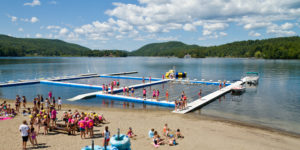 Back in college I spent a summer lifeguarding, teaching swimming lessons, and coaching swim team at an all-girls sleep away camp in upstate New York. As all lifeguards and water safety instructors do, I went through weeks of training to receive these certifications and at the end of the day, I felt confident in my ability to save the life of a drowning or injured child should an unfortunate circumstance arise. Thankfully, our beach was home to nothing more than a few minor cuts and scrapes over the course of the nine weeks of camp.
Back in college I spent a summer lifeguarding, teaching swimming lessons, and coaching swim team at an all-girls sleep away camp in upstate New York. As all lifeguards and water safety instructors do, I went through weeks of training to receive these certifications and at the end of the day, I felt confident in my ability to save the life of a drowning or injured child should an unfortunate circumstance arise. Thankfully, our beach was home to nothing more than a few minor cuts and scrapes over the course of the nine weeks of camp.
Though it would be nice if the reason behind our incident-free beach was the amazing swimming skills of our campers, I can assure you this wasn’t the case. As I mentioned, I taught swimming lessons and coached swim team and therefore knew enough about the sport to even now – 11 years later – state with certainty that not a single Olympian swam in one of my lanes.
But in all seriousness, here’s why I believe our beach was so safe:
1. Every single staff member who worked on the waterfront (boating, sailing, swimming, and water skiing instructors; swim teach coaches; and waterfront supervisors) was an American Red Cross certified lifeguard.
2. Waterfront staff initially assumed that every single camper, regardless of age, had absolutely no idea how to swim. Each camper was put through a series of basic – and then if appropriate, intermediate and advanced – skills tests to determine which areas of the waterfront and swimming beach they would be allowed to access.
3. Because the bottom of the lake was black, campers were required to wear camp-issued swim caps in the water. (It is very difficult to see people under the water in a black-bottom lake; light and brightly-colored swim caps would make a drowning victim easier to spot as they went under.)
4. Only US Coast Guard-approved life jackets were permitted and available; there were no floaties of any kind, and kick boards and pull buoyies were used only for swim team practice.
5. The waterfront rules were taught to every single camper on the very first day of camp. These rules were strict, and they were enforced.
There are lessons to be learned from how most summer camps run their waterfronts, lessons to help us keep our families safe during the next few months when we’ll likely be spending a good deal of time at the pool or beach.
1. Swim in pools and lakes that are supervised by lifeguards, and if this isn’t an option (backyard or small, neighborhood pools, for example), take on the responsibility of guarding the lives of your children and loved ones yourself.
2. Don’t assume that those you’re with – children or adults – are strong swimmers, and don’t overestimate your own swimming skills. Learn how to tell if a swimmer is in distress or is drowning, as well as how and when to call for emergency help. Better yet, learn CPR.
3. Take precautions and be prepared according to your location and the body of water in which you’re swimming. Keep a ring buoy, pole, or rope on hand to reach someone who is struggling and has drifted away from the shore or edge of the pool, and make sure a first aid kit and cell or cordless phone are immediately available.
4. Insist that weak swimmers wear US Coast Guard-approved life jackets (NOT floaties) whenever they are in OR around water, and that everyone wear US Coast Guard-approved life jackets when boating.
5. Learn, follow, teach, and enforce all public and private pool, beach, waterpark, and boating rules. These rules are there for a very good reason: they save lives.
Happy summer swimming!
Contact your local American Red Cross chapter for more information about learning to swim, water safety, home pool safety, and first aid and CPR classes.
